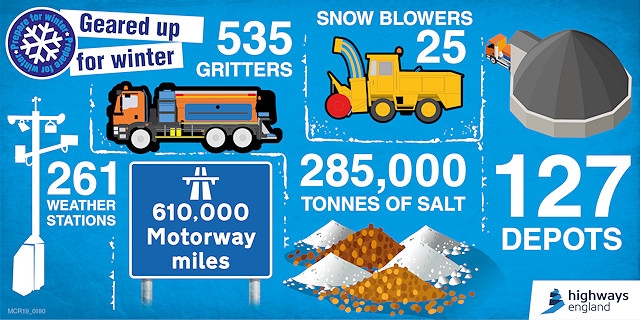Highways England prepares for first cold snap
Date published: 02 October 2019

Highways England winter infographic
As temperatures reached a record-breaking high this summer, Highways England was busy preparing to keep drivers moving this winter, and Tuesday (1 October) marks the start of its winter season.
The company responsible for the country’s motorways and major A roads has spent the last six months gearing up for winter and ensuring its 500 gritters are ready to help drivers get to their destinations safely.
The launch comes after a weekend of rainy conditions across many parts of the country.
Highways England’s national winter and severe weather team leader, Paul Furlong, said: “It’s never too early to prepare for winter. Whether people are heading to friends and family or commuting to work, we care about people’s journeys and when the wintry weather does arrive our 1,300 specially trained gritter drivers will be ready to work around the clock to keep traffic moving.
“Safety is our priority and we’re asking drivers to make sure they and their vehicles are also prepared for any eventuality. Remember, this winter, before you set out, check your vehicle, the road conditions and the weather forecast. If conditions are poor, and journeys are not essential, consider waiting until the weather gets better – this should improve journeys, and give our gritters a chance to treat the roads.”
To monitor the weather around the clock Highways England has over 250 weather stations at locations across its network. Overhead warning signs can also be used to advise motorists of severe weather.
To help keep drivers on the move this winter, Highways England has:
- 535 gritters which have all gone through a 20-hour service this summer
- 127 depots based at strategic points across the network
- 25 snow blowers which can remove between 1,200 and 2,500 tonnes of snow per hour
- More than 280,000 tonnes of salt, which can cover 610,000 lane-miles of motorway
During severe winter weather drivers are urged to follow this advice:
In snow and ice
Drivers should stick to the main roads where they can and only travel if necessary. Drivers are also encouraged to make sure they have a winter kit in their vehicle, including an ice scraper and de-icer, warm clothes and blankets and sunglasses to cope with the low winter sun.
In high winds
Drivers should slow down and avoid using exposed sections of road if possible. Lorries, caravans and motorbikes are at particular risk.
In heavy rain
Drivers should keep well back from the vehicle in front, gradually ease off the accelerator if the steering becomes unresponsive, and slow down if the rain and spray from vehicles makes it difficult to see and be seen.
In fog
Drivers should switch on their fog lights and not use lights on full beam as the fog will reflect the light back. If drivers really cannot see, they should consider stopping until it is safe to continue.
In freezing rain
Drivers should keep their distance and reduce their speed – black ice is difficult to see, so even when conditions seem normal, it can be slippery leading to very dangerous driving conditions.
For advice about driving on motorways visit:
To keep informed about driving conditions during their journeys, drivers are advised to follow messages on the overhead signs and listen to radio updates.
Further information can be found by visiting www.highways.gov.uk/traffic or calling the Highways England Information Line on 0300 123 5000.
Do you have a story for us?
Let us know by emailing news@rochdaleonline.co.uk
All contact will be treated in confidence.
Most Viewed News Stories
To contact the Rochdale Online news desk, email news@rochdaleonline.co.uk or visit our news submission page.
To get the latest news on your desktop or mobile, follow Rochdale Online on Twitter and Facebook.

